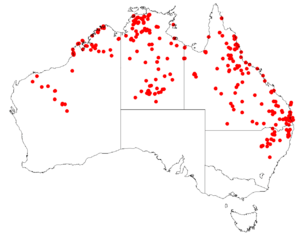Amyema bifurcata facts for kids
Quick facts for kids Amyema bifurcata |
|
|---|---|
 |
|
| Amyema bifurcata, Burning Mountain, New South Wales | |
| Conservation status | |
|
Least Concern (NCA)
|
|
| Scientific classification | |
| Genus: |
Amyema
|
| Species: |
bifurcata
|
 |
|
| Collections data for A. bifurcata from the Australasian Virtual Herbarium | |
| Synonyms | |
|
Amyema ferruginiflora (W.Fitzg.) Danser |
|
Amyema bifurcata is a special kind of plant that grows on other plants. It is a flowering hemiparasitic plant from the Loranthaceae family, also known as the mistletoe family. This plant is native to Australia. You can find it growing in Western Australia, the Northern Territory, Queensland, and New South Wales.
Contents
What Does Amyema bifurcata Look Like?
This plant has unique flowers that grow in groups. These groups are called an umbel, which means the flower stalks all come from one point, like the spokes of an umbrella. Each group has two or more pairs of flowers.
Flower and Fruit Details
The flowers have a rusty color. They are covered with thick, tangled hairs. After the flowers, the plant produces round fruits. A special leaf-like part called a bract grows larger under each fruit. The leaves of Amyema bifurcata are flat.
Where Does Amyema bifurcata Grow?
Amyema bifurcata is a hemiparasitic plant. This means it attaches itself to other plants and gets some of its water and nutrients from them. It does not usually harm the host plant too much.
Host Plants
This plant grows on many different types of trees. It can be found on about 22 kinds of Eucalyptus trees. It also grows on five kinds of Angophora trees. Sometimes, you can find it on Acacia acuminata and Nitraria billardierei plants as well. These are all common trees and shrubs found in Australia.
How Was Amyema bifurcata Named?
Plants are given scientific names so that scientists all over the world can identify them easily. This plant was first described by a scientist named Bentham in 1867. He gave it the name Loranthus bifurcatus.
Changing Names
Later, in 1894, another scientist named Tieghem changed its genus. The genus is the first part of a plant's scientific name. He moved it to the Amyema genus, which is why its full name is now Amyema bifurcata.

